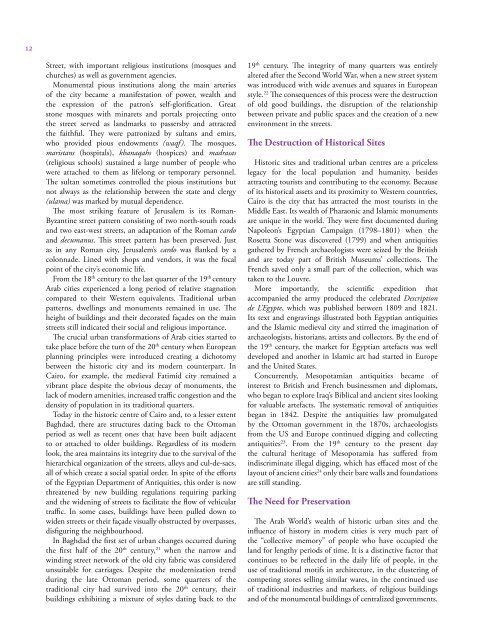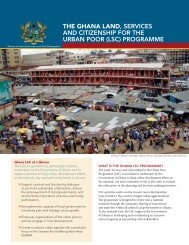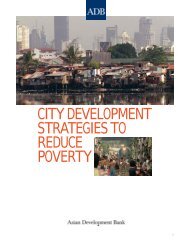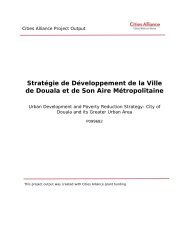Arab Cities2012 - Cities Alliance
Arab Cities2012 - Cities Alliance
Arab Cities2012 - Cities Alliance
Create successful ePaper yourself
Turn your PDF publications into a flip-book with our unique Google optimized e-Paper software.
12<br />
Street, with important religious institutions (mosques and<br />
churches) as well as government agencies.<br />
Monumental pious institutions along the main arteries<br />
of the city became a manifestation of power, wealth and<br />
the expression of the patron’s self-glorification. Great<br />
stone mosques with minarets and portals projecting onto<br />
the street served as landmarks to passersby and attracted<br />
the faithful. They were patronized by sultans and emirs,<br />
who provided pious endowments (waqf). The mosques,<br />
maristans (hospitals), khanaqahs (hospices) and madrasas<br />
(religious schools) sustained a large number of people who<br />
were attached to them as lifelong or temporary personnel.<br />
The sultan sometimes controlled the pious institutions but<br />
not always as the relationship between the state and clergy<br />
(ulama) was marked by mutual dependence.<br />
The most striking feature of Jerusalem is its Roman-<br />
Byzantine street pattern consisting of two north-south roads<br />
and two east-west streets, an adaptation of the Roman cardo<br />
and decumanus. This street pattern has been preserved. Just<br />
as in any Roman city, Jerusalem’s cardo was flanked by a<br />
colonnade. Lined with shops and vendors, it was the focal<br />
point of the city’s economic life.<br />
From the 18 th century to the last quarter of the 19 th century<br />
<strong>Arab</strong> cities experienced a long period of relative stagnation<br />
compared to their Western equivalents. Traditional urban<br />
patterns, dwellings and monuments remained in use. The<br />
height of buildings and their decorated façades on the main<br />
streets still indicated their social and religious importance.<br />
The crucial urban transformations of <strong>Arab</strong> cities started to<br />
take place before the turn of the 20 th century when European<br />
planning principles were introduced creating a dichotomy<br />
between the historic city and its modern counterpart. In<br />
Cairo, for example, the medieval Fatimid city remained a<br />
vibrant place despite the obvious decay of monuments, the<br />
lack of modern amenities, increased traffic congestion and the<br />
density of population in its traditional quarters.<br />
Today in the historic centre of Cairo and, to a lesser extent<br />
Baghdad, there are structures dating back to the Ottoman<br />
period as well as recent ones that have been built adjacent<br />
to or attached to older buildings. Regardless of its modern<br />
look, the area maintains its integrity due to the survival of the<br />
hierarchical organization of the streets, alleys and cul-de-sacs,<br />
all of which create a social spatial order. In spite of the efforts<br />
of the Egyptian Department of Antiquities, this order is now<br />
threatened by new building regulations requiring parking<br />
and the widening of streets to facilitate the flow of vehicular<br />
traffic. In some cases, buildings have been pulled down to<br />
widen streets or their façade visually obstructed by overpasses,<br />
disfiguring the neighbourhood.<br />
In Baghdad the first set of urban changes occurred during<br />
the first half of the 20 th century, 21 when the narrow and<br />
winding street network of the old city fabric was considered<br />
unsuitable for carriages. Despite the modernization trend<br />
during the late Ottoman period, some quarters of the<br />
traditional city had survived into the 20 th century, their<br />
buildings exhibiting a mixture of styles dating back to the<br />
19 th century. The integrity of many quarters was entirely<br />
altered after the Second World War, when a new street system<br />
was introduced with wide avenues and squares in European<br />
style. 22 The consequences of this process were the destruction<br />
of old good buildings, the disruption of the relationship<br />
between private and public spaces and the creation of a new<br />
environment in the streets.<br />
The Destruction of Historical Sites<br />
Historic sites and traditional urban centres are a priceless<br />
legacy for the local population and humanity, besides<br />
attracting tourists and contributing to the economy. Because<br />
of its historical assets and its proximity to Western countries,<br />
Cairo is the city that has attracted the most tourists in the<br />
Middle East. Its wealth of Pharaonic and Islamic monuments<br />
are unique in the world. They were first documented during<br />
Napoleon’s Egyptian Campaign (1798–1801) when the<br />
Rosetta Stone was discovered (1799) and when antiquities<br />
gathered by French archaeologists were seized by the British<br />
and are today part of British Museums’ collections. The<br />
French saved only a small part of the collection, which was<br />
taken to the Louvre.<br />
More importantly, the scientific expedition that<br />
accompanied the army produced the celebrated Description<br />
de L’Egypte, which was published between 1809 and 1821.<br />
Its text and engravings illustrated both Egyptian antiquities<br />
and the Islamic medieval city and stirred the imagination of<br />
archaeologists, historians, artists and collectors. By the end of<br />
the 19 th century, the market for Egyptian artefacts was well<br />
developed and another in Islamic art had started in Europe<br />
and the United States.<br />
Concurrently, Mesopotamian antiquities became of<br />
interest to British and French businessmen and diplomats,<br />
who began to explore Iraq’s Biblical and ancient sites looking<br />
for valuable artefacts. The systematic removal of antiquities<br />
began in 1842. Despite the antiquities law promulgated<br />
by the Ottoman government in the 1870s, archaeologists<br />
from the US and Europe continued digging and collecting<br />
antiquities 23 . From the 19 th century to the present day<br />
the cultural heritage of Mesopotamia has suffered from<br />
indiscriminate illegal digging, which has effaced most of the<br />
layout of ancient cities 24 only their bare walls and foundations<br />
are still standing.<br />
The Need for Preservation<br />
The <strong>Arab</strong> World’s wealth of historic urban sites and the<br />
influence of history in modern cities is very much part of<br />
the “collective memory” of people who have occupied the<br />
land for lengthy periods of time. It is a distinctive factor that<br />
continues to be reflected in the daily life of people, in the<br />
use of traditional motifs in architecture, in the clustering of<br />
competing stores selling similar wares, in the continued use<br />
of traditional industries and markets, of religious buildings<br />
and of the monumental buildings of centralized governments.
















